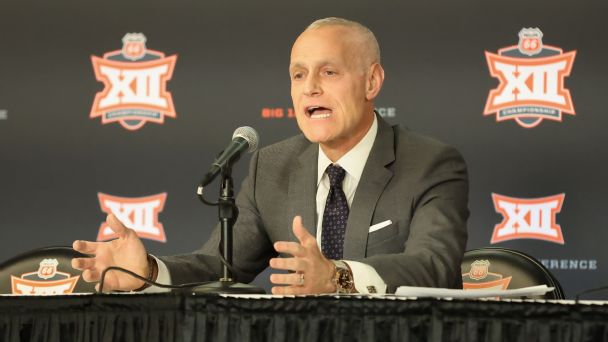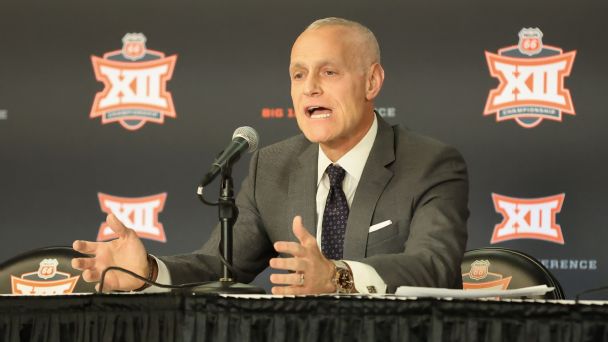
WASHINGTON, D.C. — The Colorado football program hasn’t won a league title since 2001, sputtered to a 1-11 mark last season and has hibernated on the south side of mediocrity for the better part of two decades.
Despite that, Colorado has somehow managed to become the most compelling program in all of college athletics. Deion Sanders’ arrival as head coach has coincided with the school positioning itself as a potential linchpin for the next round of conference realignment.
Keeping Up With Colorado has been the sport’s smash hit of the offseason — Louis Vuitton luggage coming in, waves of players heading out and school officials mulling a new conference partner. Welcome to the college football offseason in 2023 — reality television plotlines becoming the industry’s reality.
With the season’s kickoff still nearly three months away, Colorado’s conference affiliation has become the centerpiece of realignment speculation. Here in the dog days of June, the periscopes of paranoia from campuses and conference offices around the country are locked in on Boulder.
How will the Pac-12’s impending TV deal impact Colorado and the Big 12? When will the SEC and Big Ten think about more expansion? And what’s going on with the ACC? Here’s a peek at some potential answers to realignment’s biggest questions after talking to power brokers in all corners of the college sports industry.
Jump to:
Big 12 expansion | Pac-12 TV latest
What’s next for Big Ten, SEC | ACC latest
What will Colorado do?
Here’s the bottom line on Colorado. It has met with the Big 12. It has been in the Big 12 in a prior life, leaving after the 2010-11 season.
It remains improbable the Buffaloes leave for the Big 12 until the Pac-12 presidents get a firm sense of what their next television deal is going to look like. Colorado chancellor Phil DiStefano has said as much. However, sources told ESPN that Colorado’s patience has waned, which prompted the in-person meeting with the Big 12 back in May.
Still, realignment decisions are made by university officials and boards, who are historically not as bold as Coach Prime. This is a legacy move for DiStefano and athletic director Rick George, as it impacts the whole university for the next generation. As Arizona president Bobby Robbins said in Washington, D.C., last week, Pac-12 schools are preparing to make decisions once the league delivers details on the TV contract. “I think it’s going to be quick,” Robbins said. “I really do.”
When will those numbers come in?
The latest timeline for a deal came from Washington State president Kirk Schulz, who predicted by the end of June in a board meeting on Friday. Holding the Pac-12 to Schulz’s date may be foolish, as it came in the context of him trying to get board approval for a budget, not a hard-and-fast deadline. The most realistic expectation for the Pac-12 remains later this summer.
The Pac-12 won’t be blindsided if Colorado does end up leaving. It has been acknowledged around the league that the Buffaloes would be replaced by San Diego State, a quick solution that delivers a desirable market.
But it’s also not as simple as plug and play, since the symbolism of Colorado leaving would likely mean more than the actual defection, leading to more departures and uncertainty.
Who else could end up jumping to the Big 12?
The prospect of Colorado leaving for the Big 12 is real enough that schools are already jockeying to see who could join them.
It is instructive that Big 12 commissioner Brett Yormark denied meeting with Memphis about joining the conference but hasn’t denied contact with Colorado and UConn. For now, the Memphis interest remains strongest on Memphis’ side, as they are just part of the Big 12’s whiteboard of potential additions.
Sources say the Big 12 has held an in-person visit with school officials at Colorado at a neutral site. And they’ve also had an on-campus visit to Connecticut. That UConn meeting has some predicting that if Colorado does jump to the Big 12, UConn is a top choice if none of the other Four Corner schools — Arizona, Arizona State, Utah — join the Buffaloes.
But there’s also a notion bubbling up in the Big 12 that patience may be the most prudent option if Colorado ends up joining the league in the upcoming months. (This assumes no one else from the Pac-12 comes with them.)
The Big 12’s main objective is fortifying the league with the best brands and markets to maximize revenue in the league’s next television deal, which comes up after the 2030 football season. Could they see if some of the aggrieved ACC schools end up breaking away and attempt to poach some of the leftovers?
“There’s a lot of unhappiness in the ACC right now,” said a Big 12 source. “Why not see what happens with the Pac-12 and the ACC a little more before making any decisions?”
Every Pac-12 school with options has been exploring potential moves, as the league’s protracted timeline for a TV deal has made it irresponsible for schools or their representatives not to pick up the phone and see what’s out there.
If the Pac-12 numbers don’t materialize by the time media days roll around in mid-July, perhaps schools will get a little more anxious. But for now, waiting and making other moves to maximize revenue — like the recent Mexico initiative — looks like the Big 12’s short-term course of action.
Can the Pac-12 keep things together?
Yes, it can. The stakes here have been clear and haven’t really changed since we visited this topic in March.
The future of the league rests on commissioner George Kliavkoff delivering a television deal and coinciding grant of rights that’s flush with enough money to keep the league together. Nothing else matters.
Robbins, the University of Arizona president, said last week he’s optimistic the league stays together. But call around to the traditional television partners and those in the industry who know where money flows, and there’s still an aura of mystery to how the Pac-12 gets it done.
Until both the deal and grant of rights — which ties each school’s TV money to the conference for the duration of the deal — are signed, uncertainty remains. Have-nots like Oregon State and Washington State remain hopeful. The schools with options to upgrade continue to explore them.
Robbins spoke extensively about Arizona and the other schools needing to see the numbers of the upcoming deal before any moves are made. “I’ve seen forecasts and projections,” Robbins said. “I do think there’s good data on what the Pac-12 is valued at. I’ve seen those numbers. If we get close to those numbers, I think we’ll be fine.”
Once the numbers arrive, schools still have to agree to their grant of rights for that amount and length of time. Robbins was cagey when asked about reports that the grant of rights have already been agreed to, saying essentially that the presidents need to see a deal. “Show me the data,” he said. “We’ve got to see the data, and I think that’s what everybody’s waiting on. And it sounds like it’s coming soon.”
Per a source, the league has already decided if there’s an early exit fee and what it would look like for any school attempting to leave the conference early. “It allows the league to move faster once the media partners are set to announce a deal,” said a Pac-12 source of the early grant-of-rights discussions.
This shroud of uncertainty can all go away for the Pac-12 if the television deal has a numeric value and comparable reach to a deal like the Big 12’s, which delivers about $31.7 million annually to each school.
Sign a comparable deal and this stretch of Pac-12 awkwardness, vulnerability and uncertainty becomes a distant memory. But no one is still quite sure where the money and exposure are coming from.
“Right now, everyone’s dance card is pretty full,” an industry source told ESPN this weekend.
When will the Big Ten or SEC be back in the realignment business?
The term Power Two is the most accurate way to describe the current college athletics landscape. As that moat increases between the Big Ten, SEC and everyone else, the plotting to get across the moat over the course of the next decade will dominate decision making.
While the Big Ten and SEC have both prided themselves on distinctly different league cultures, there’s a turf war looming in the distance as big brands inevitably creep up to the Power Two: Who can land Virginia and North Carolina?
Both leagues are peering at each other from their respective league headquarters. Neither wants to be overtly destructive or accused of tortious interference. (That’s legalese for prying a school out of a current contract, as the expiring deals of the Big 12 and Pac-12 allowed the marquee defections from there in recent years.)
But neither league wants to be a step behind the other. So they watch and wait.
This is what makes the prospect of landing North Carolina and Virginia integral in both leagues’ down-the-road expansion plans. Outside of Notre Dame, there are no programs that will be as coveted by the SEC and Big Ten thanks to both geography and market.
To be clear, none of this is imminent. SEC commissioner Greg Sankey said publicly last year that his league is happy to stay at 16 teams for now. The Big Ten has a new commissioner, Tony Petitti, and a current television deal to iron out. It’s coming off league leaders shooting down a late push by Kevin Warren to bring in Oregon and Washington.
Meanwhile, all 14 ACC teams are tied to the league through a TV contract with ESPN that runs through 2036. And sources around the league are skeptical of an imminent breakaway attempt. It’s just too complicated, given the legal and financial questions.
It’s important to remember that expansion desirability does not directly correlate to football success, which is why there may be smoke coming out of Clemson’s fans’ ears reading this. Florida State and Miami, too. Think about the additions of Texas A&M and Missouri to the SEC or Rutgers and Maryland to the Big Ten, none of which has won a league football title since arriving.
North Carolina and Virginia mark a geographic, population and recruiting battleground for the SEC and Big Ten. They are desirable media markets and could help with student recruiting, as they are the No. 9 (North Carolina) and No. 12 (Virginia) most populous states in the country.
Both North Carolina and Virginia are in contiguous states for both leagues. (Notre Dame is, too, with Indiana bordering Kentucky and amid the Big Ten footprint.)
It was always theorized to be former Big Ten commissioner Jim Delany’s ideal scenario to someday lure his alma mater, UNC, to the Big Ten, and that the Maryland and Rutgers move opened up the I-95 corridor to make it happen. He just ran out of time.
Will one of his successors be able to pull it off?
What can keep the ACC together long term?
An ACC source indicated this week that the best hope for the league to stay together in the long term may be some type of additional unequal revenue sharing that goes beyond the recent revenue adjustments.
The seven have-not schools in the league are facing an existential question. Do they give up more money to the league’s top earners and those who draw the biggest audiences? Or do they eventually find out the value of a league with Boston College, Syracuse, Pittsburgh, Louisville, Duke, Wake Forest and Georgia Tech? It’s hard to imagine it would be comparable.
Unequal revenue sharing has long been viewed as a league killer. That’s why there’s a damned-if-they-do, damned-if-they-don’t feel in the ACC right now.
Unequal revenue sharing eventually split up the Big 12, helping send Nebraska, Missouri and Texas A&M running more than a decade ago.
On the flip side, USC and UCLA left the Pac-12 in part because the league didn’t stress it as an option.
But telling schools that are already pressed financially to give up millions to their in-conference competitors is a difficult administrative pill to swallow. Of course, so is being relegated to an inferior league for less money down the road.
It’s also hard to imagine the league looking similar in five years. So when does discontent lead to action?
No one knows. If the seven ACC schools that have met about alternative options — Clemson, Florida State, Miami, Virginia, Virginia Tech, North Carolina and NC State — leave together, they really don’t have a lucrative future tied to each other.
The breakaway ACC schools would need to go to another league for a better pay day than the current one. And they’d need to cleanse themselves of legal issues relating to their departure before another league would feel good taking them.
So does that leave re-slicing the current ACC pie a better option for all?










